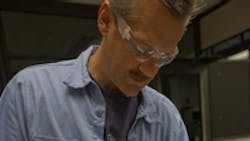Designers Aren't the Only Ones Innovating at General Motors
Three-dimensional rapid-prototyping technology has enabled technicians at General Motors to fabricate almost any part in a fraction of the time it once took.
The skilled-trades technicians have leveraged the technology between their ears to boost efficiency even further.
Traditionally, only virgin resins were used for rapid prototyping. But the technicians at GM's 3-D Rapid Prototype Lab in Warren, Mich., developed a recycling process for the powered selective laser sintering material.
The shop staff worked with 3D Systems, the equipment supplier, to extract a portion of the used material and return it to the delivery vessels, where it is blended with virgin material for future use.
The lab technicians, members of United Auto Workers Local 160, can directly transfer digital designs for just about any part on a car or truck to the selective laser sintering or stereo lithography machines that generate parts in hours without any dedicated tooling.
The only limitation beyond a designer's imagination is the physical size of the machines.
Parts being generated must be no larger than the 500- by 500- by 750-millimeter dimensions of the fabrication chambers that contain the powered plastic or liquid resin.
That's no problem for smaller pieces like interior trim or parts for a one-third-scale model to be tested in GM's wind tunnel. As part orders come in from GM design and engineering facilities around the world, technicians use a graphical design program to arrange computer models of the parts within the envelope of the chamber to maximize the output of every batch.
"As long as the parts aren't touching, we can keep filling the envelope," said technician Timothy Breault. "When we get hot orders for parts that are small enough, we can even add them on the fly to the top of a build that is already in progress."
No Trimming or Filling Necessary
Larger parts suitable for full-scale wind tunnel testing, such as the lower front splitter for the 2013 Camaro ZL1, require a different approach.
In this case, the lab techs developed a mechanism that allows the joining of multiple smaller pieces to make one larger part. As they prepare build sets, larger parts can now be sliced into multiple smaller sections that fit within the rapid-prototyping machines.
Thanks to the precise forming that is possible with rapid-prototyping manufacturing, integrated lap joints with a series of matching holes can be generated so that no drilling is required for assembly.
After the parts cool, the segments are temporarily connected with standard Cleco expanding fasteners while being assembled.
The technicians also devised standard joining pins that are produced in the rapid-prototyping machine from the same material as the rest of the part. Pins are snipped off, glued into the holes and then trimmed with a rotary tool.
The rapid-prototyping machines produce parts to such precise tolerances that virtually no trimming or filling is required and the seams are almost invisible.
"Things that we do now within a day or two days, would take months to build by hand," said Michael Marchwinski, a lab technician who began his career at GM Design 28 years ago as an apprentice wood model maker.
